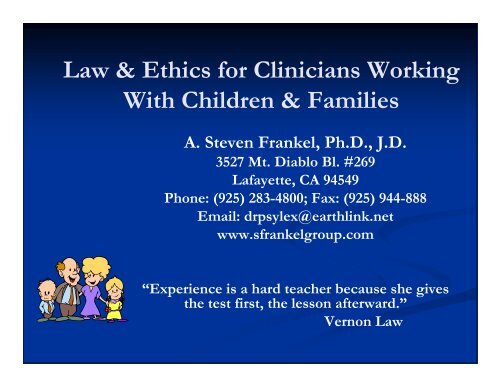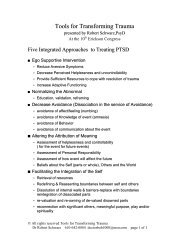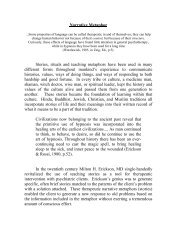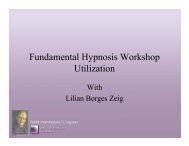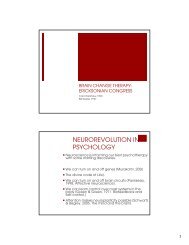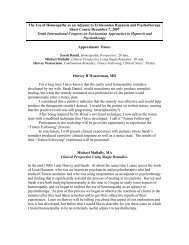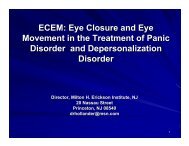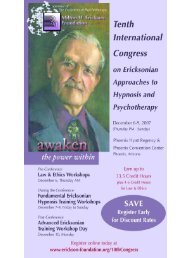Law & Ethics for Clinicians Working With Children & Families
Law & Ethics for Clinicians Working With Children & Families
Law & Ethics for Clinicians Working With Children & Families
You also want an ePaper? Increase the reach of your titles
YUMPU automatically turns print PDFs into web optimized ePapers that Google loves.
<strong>Law</strong> & <strong>Ethics</strong> <strong>for</strong> <strong>Clinicians</strong> <strong>Working</strong><br />
<strong>With</strong> <strong>Children</strong> & <strong>Families</strong><br />
A. Steven Frankel, Ph.D., J.D.<br />
3527 Mt. Diablo Bl. #269<br />
Lafayette, CA 94549<br />
Phone: (925) 283-4800; Fax: (925) 944-888<br />
Email: drpsylex@earthlink.net<br />
www.sfrankelgroup.com<br />
“Experience is a hard teacher because she gives<br />
the test first, the lesson afterward.”<br />
Vernon <strong>Law</strong>
Introduction<br />
My background.<br />
I hate risk management<br />
seminars.<br />
Preview of handouts/references.<br />
Questions can be posed orally or<br />
in writing (don’t trust me after<br />
4:00 pm).
Duty To Warn<br />
Hypothetical:<br />
1. Blended family<br />
2. After a session with the couple<br />
Wife calls to tell you that she ran<br />
into her ex- had a nice<br />
conversation and reported this<br />
to her new husband, who flew<br />
into a rage and threatened to<br />
kill the ex. NOW WHAT?
Tarasoff: In the Beginnng….<br />
Tarasoff 1:<br />
Facts<br />
Holding
Tarasoff<br />
Tarasoff 2: worser & worser
C. Civil Code § 43.92<br />
(The “Tarasoff statute”)<br />
a) There shall be no monetary liability on the part<br />
of, and no cause of action shall arise against,<br />
any person who is a psychotherapist…in failing<br />
to warn of and protect from a patient’s<br />
threatening and violent behavior or failing to<br />
predict and warn of and protect from a patient’s<br />
violent behavior except where the patient has<br />
communicated to the psychotherapist a serious<br />
threat of physical violence against a reasonably<br />
identifiable victim or victims.
Civil Code § 43.92<br />
(The “Tarasoff statute”)<br />
b) If there is a duty to warn and<br />
protect under the limited<br />
circumstances specified above,<br />
the duty shall be discharged by<br />
the psychotherapist making<br />
reasonable ef<strong>for</strong>ts to communicate<br />
the threat to the victim or victims<br />
and to a law en<strong>for</strong>cement agency.
What’s What s a Tarasoff Report?<br />
1. The threatener (patient);<br />
2. The intended victim(s);<br />
3. The nature of the threat;<br />
4. What makes the threat<br />
“serious.”
Post-Tarasoff<br />
Post Tarasoff Report<br />
Confidentiality-Cali<strong>for</strong>nia<br />
Confidentiality Cali<strong>for</strong>nia<br />
A. The elements of the report lose<br />
their privileged status and are<br />
admissible in Court.<br />
B. All other assessment &<br />
treatment records remain<br />
confidential/privileged.<br />
[“Menendez II” Menendez v. Superior Court (1992)<br />
3 Cal.4 th 435]
Post-Tarasoff<br />
Post Tarasoff Report<br />
Confidentiality-Federal<br />
Confidentiality Federal<br />
Both the elements of the report and<br />
all other assessment & treatment<br />
records are confidential, privileged<br />
and inadmissible – professionals<br />
are not free to testify absent Court<br />
Order.<br />
[United States v. Chase, No. 01-30200 (9th Cir.08/22/2003)]
Tarasoff<br />
Ewing v. Goldstein:<br />
A problem of MAJOR<br />
proportions!!!!!!
Duty To Warn<br />
Hypothetical:<br />
1. Blended family<br />
2. After a session with the couple<br />
Wife calls to tell you that she ran<br />
into her ex- had a nice<br />
conversation and reported this to<br />
her new husband, who flew into a<br />
rage and threatened to kill the ex.<br />
NOW WHAT?
Third Party <strong>Law</strong>suits<br />
Hypothetical:<br />
1. County intern treats adolescent<br />
and family as well;<br />
2. Adolescent is adopted, has<br />
learning and behavioral<br />
problems – observable early in<br />
life – rx by psychiatrist;<br />
3. Birth mother stays in touch<br />
intermittently
Third Party <strong>Law</strong>suits<br />
4. Parents request IEP at age 17.<br />
5. Evaluator & intern agree that<br />
mom is enmeshed – reject any<br />
Axis I or II disorder in<br />
adolescent & deliver this<br />
<strong>for</strong>mulation to the entire family.<br />
6. Mom is crushed, needs<br />
psychiatric visits & meds.
Third Party <strong>Law</strong>suits<br />
7. Just prior to graduation, she is very<br />
stressed and the issue of her having<br />
her birth mother come to graduation<br />
comes up: “I’m not ready to meet her<br />
yet.”<br />
8. Birth mother tells adoptive parents<br />
that there’s a birth brother.<br />
9. Parents tell intern, but request<br />
confidentiality.
Third Party <strong>Law</strong>suits<br />
10. At last session (services stop<br />
when adolescent is 18), intern tells<br />
her about her birth brother.<br />
Adolescent graduates, but spends<br />
the next 1.5 years screaming at<br />
adoptive parents <strong>for</strong> deceiving her,<br />
shuttling back & <strong>for</strong>th between<br />
birth mom & brother vs. adoptive<br />
home, ends up with panic disorder<br />
and hospitalization.
Third Party <strong>Law</strong>suits<br />
SO – WHO IS LIABLE,<br />
AND FOR WHAT?<br />
1. County?<br />
2. Intern?<br />
3. Supervisor?<br />
4. IEP Evaluator?
Third Party Causes of Action<br />
Can a non-patient sue you? Generally, NO, but<br />
1. Diagnostic evaluators (Schwarz v. Regents<br />
of UC (1990)).<br />
2. Negligent infliction of emotional<br />
distress:<br />
a. Closely related;<br />
b. Present when injury occurs and is<br />
aware that it is harmful;<br />
c. Suffers emotional distress more than a<br />
disinterested witness (Thing v. La<br />
Chusa (1989))<br />
3. Reasonably <strong>for</strong>eseeable harm (Molien v.<br />
Kaiser, (1980))
Third Party <strong>Law</strong>suits<br />
SO – WHO IS LIABLE,<br />
AND FOR WHAT?<br />
1. County?<br />
2. Intern?<br />
3. Supervisor?<br />
4. IEP Evaluator?
“Abuse of Transference”<br />
Creating Dependency<br />
Exploitation<br />
All “sex cases”
Abuse of Transference<br />
Hypothetical:<br />
Female pt. is adult survivor of<br />
sexual abuse with dx of bipolar<br />
disorder, learning disabilities<br />
and chemical dependency.<br />
Clinician cares deeply about all<br />
people including pt., shares a lot<br />
about her own life story<br />
intending to encourage pt.
Abuse of Transference<br />
Toward the end of 3 rd year of<br />
treatment, pt. consults with<br />
attorney, indicating that she has<br />
spent time at clinician’s home,<br />
has paid <strong>for</strong> tx by doing<br />
secretarial work, which has<br />
included doing personal errands<br />
(e.g. shopping) <strong>for</strong> clinician, etc.
Abuse of Transference<br />
Pt. also tells attorney that<br />
she has sat on clinician’s<br />
lap <strong>for</strong> com<strong>for</strong>t, that<br />
clinician also touched her<br />
inappropriately, telling<br />
her that loving feelings<br />
are OK and that “safe<br />
touch” is OK.
Abuse of Transference<br />
Patient wins large<br />
settlement and<br />
clinician loses license.
“Abuse of Transference”<br />
Creating Dependency<br />
Exploitation<br />
All “sex cases”
Abuse of Transference<br />
Slippery Slopes:<br />
1. This patient is special.<br />
2. I’m uniquely qualified to<br />
treat pt.<br />
3. Others may not approve,<br />
but pt. is growing.
PROFESSIONAL RECORDS<br />
Hypothetical:<br />
1. Custody evaluation in remote<br />
county with loose rules about<br />
<strong>for</strong>malities – no written order.<br />
2. Mom’s new BF is to be<br />
included in the eval by<br />
agreement of judge, all<br />
attorneys and parties.<br />
3. BF claims years of experience<br />
as a legal researcher, assents<br />
to eval but won’t sign.
Professional Records<br />
4. Eval is less-than-flattering to<br />
BF, who goes ballistic when it’s<br />
admitted into evidence.<br />
5. BF files board complaint – no<br />
relief.<br />
6. BF tries professional societies –<br />
no relief<br />
7. BF finds HIPAA – minor<br />
violation addressable via letter<br />
of apology.<br />
8. BF launches into actions<br />
against evaluator.
Professional Records<br />
9. Evaluator incurs about<br />
$5-10k in legal fees<br />
fighting Order to destroy<br />
BF’s records so he won’t<br />
be left with no evidence<br />
to defend himself if<br />
needed.
Professional Records<br />
Moral of the Story:<br />
Record-keeping begins<br />
with in<strong>for</strong>med consent<br />
(and don’t trust anyone<br />
who won’t “put it in<br />
writing”)
Professional Records<br />
The standard of care: all mental<br />
health professionals are required<br />
to keep contemporaneous<br />
records of all services provided.<br />
NEVER CHANGE A RECORD!<br />
(without documenting the change).
Professional Records<br />
Three Controversies:<br />
1. Process vs. Progress Notes;<br />
2. Privacy: how much to write;<br />
3. Changes to Health<br />
Insurance Portability and<br />
Accountability Act (HIPAA).
Professional Records & HIPAA<br />
You need to know:<br />
i. Don’t panic: it’s only now<br />
becoming clear as to how<br />
many/which state laws will be<br />
preempted by HIPAA.<br />
ii. You need a privacy statement.<br />
iii. You need release <strong>for</strong>ms <strong>for</strong><br />
disclosures/amendments.<br />
iv. You need to separate “the<br />
record” from the “psychotherapy<br />
notes.”
The “Clinical Clinical Record” Record<br />
1. Anything you’d find on an<br />
insurance <strong>for</strong>m:<br />
Demographic info (name, age,<br />
address, phone, gender, etc.)<br />
Insurance info<br />
Diagnoses (DSM-IV is OK, but…)<br />
Service dates & CPT Codes<br />
Financial (billed/rec’d. etc.)
The “Clinical Clinical Record” Record<br />
2.Psychoactive medications<br />
3. Psychological testing,<br />
incl. raw data (soooo<br />
sorry!)<br />
You can make ef<strong>for</strong>ts to<br />
follow the APA <strong>Ethics</strong> Code,<br />
but you can’t “win” if push<br />
comes to shove.<br />
Cali<strong>for</strong>nia law trumps the APA<br />
<strong>Ethics</strong> Code.
Clinical Record: 4. Treatment Summary<br />
Cali<strong>for</strong>nia Health & Safety Code 123130 holds that a treatment summary<br />
may be prepared in lieu of a patient record, within 10 working days of the<br />
request (if a record is unduly long or a patient is recently discharged, 30<br />
days are allowed" but the patient must be notified in writing). Summaries<br />
must include:<br />
(1) Chief complaint or complaints including pertinent history.<br />
(2) Findings from consultations and referrals to other health care<br />
providers.<br />
(3) Diagnosis, where determined.<br />
(4) Treatment plan and regimen including medications prescribed.<br />
(5) Progress of the treatment.<br />
(6) Prognosis including significant continuing problems or conditions.<br />
(7) Pertinent reports of diagnostic procedures and tests and all discharge<br />
summaries.<br />
(8) Objective findings from the most recent physical examination, such as<br />
blood pressure? weight? and actual values from routine laboratory tests.<br />
Fees:<br />
The health care provider may charge no more than a reasonable fee based<br />
on actual time and cost <strong>for</strong> the preparation of the summary. The cost shall<br />
be based on a computation of the actual time spent preparing the summary<br />
<strong>for</strong> availability to the patient or the patient's representative. It is the intent<br />
of the Legislature that summaries of the records be made available at the<br />
lowest possible cost to the patient.
Professional Records<br />
Centers <strong>for</strong> Medicare & Medicaid (CMS): <strong>for</strong><br />
follow-up visits:<br />
A. Date, name, age, length of session;<br />
B . Reason <strong>for</strong> the encounter and pertinent interval history<br />
(note: all elements above may not have to be repeated<br />
each visit; if the frequency of visits are (sic) less than 1<br />
week the elements must be clearly understood);<br />
C. Pertinent themes discussed;<br />
D. Appropriate risk factors, where applicable;<br />
E. Interventions used, including<br />
1. Pychotherapeutic<br />
2. Medications, diagnostic test(s), consults, family, other;<br />
F. Patient assessment (progress or regression);<br />
G. Changes in treatment plan, diagnosis and medication<br />
where appropriate;<br />
H. Expected treatment outcomes on a periodic basis.
Sample HIPAA-Compliant HIPAA Compliant Record<br />
Patient name:__________________________ Date __________<br />
Length of Session______ CPT: 90806; 90818; 90847; 90853; Other________<br />
(Start___________ Finish __________)<br />
Diagnoses:________________________________________________<br />
Axis IV Psychosocial and Environmental problems addressed:<br />
____Primary support group problems ____Self-care problems<br />
____Social environment problems ____Economic stressors<br />
____Physical health problems ____Current victimization<br />
____School/work problems ___Other psychosocial stressors<br />
____Housing problems<br />
Current GAF__________; Highest GAF this year____________.<br />
Current Meds._____________________________________________.<br />
Risk issues assessed________________________________________.<br />
Consultations:_____________________________________________.<br />
Tx Plan___________________________________________________.<br />
In<strong>for</strong>med consent issues discussed this session:_________________<br />
_________________________________________________________<br />
(Signature)______________________________________
CLINICAL RECORD<br />
Client:<br />
Clinician:<br />
Prepared by Michaele P. Dunlap, Psy.D. <strong>for</strong><br />
Pragmatics of HIPAA Training 2-28-03<br />
<br />
Start Stop Tx Mode Summary recorded this session:<br />
(T) Tests/Results, (M) Med .(D) Diagnosis, (S)<br />
Symptoms (F) Functional Status (Tx P) Treatment<br />
plan, (Prog) Progress to Date (E) Prognosis<br />
Per Federal Regulation the above in<strong>for</strong>mation is documented at each client visit, and may be used or disclosed upon specific written consent of the client or the client=s<br />
authorized representative <strong>for</strong> treatment, payment or healthcare operations. No other in<strong>for</strong>mation about this client will be released by this mental health professional/mental<br />
health care entity unless specific, fully in<strong>for</strong>med authorization from the client or an authorized representative is obtained in writing, or as otherwise allowed or required by<br />
law.<br />
Statutes and regulations in this State may be more restrictive than Federal Regulation, further limiting disclosure of the above and other individually identifiable health<br />
in<strong>for</strong>mation.<br />
AS THE RECEIVING ENTITY, YOU MAY BE SUBJECT TO CIVIL AND FEDERAL CRIMINAL PENALTIES FOR IMPROPER RE-<br />
DISCLOSURE OF THIS INFORMATION.
c. “Psychotherapy Psychotherapy Notes” Notes<br />
Same as “Process Notes” ???<br />
1. Not required to keep them.<br />
2. For the benefit of the therapist.<br />
3. Patient must sign a release each<br />
time they are released, BUT<br />
4. Patient has no statutory right to see<br />
them (yeah, sure!)<br />
5. Insurance industry can’t condition<br />
payment/authorization on inspecting<br />
psychotherapy notes (in litigation –<br />
with Medicare!)
Sample HIPAA-Compliant HIPAA Compliant Psychotherapy Note<br />
Patient Name ____________________________Date__________<br />
Disclosures this session__________________________________<br />
______________________________________________________<br />
Interventions this session _______________________________<br />
______________________________________________________<br />
______________________________________________________<br />
Patient Comments/Behaviors____________________________<br />
_____________________________________________________<br />
_____________________________________________________<br />
Homework____________________________________________<br />
Signature_____________________________________________
Professional Records<br />
Retention of Records:<br />
The “7-year rule” applies to<br />
clinicians as well as agencies, but<br />
EXPOSURE to board actions<br />
runs (at the most) <strong>for</strong> 10 years<br />
after seeing an adult and, <strong>for</strong><br />
minors, when the minor turns 28!!
Lunch Break<br />
We return at 1:00.<br />
Have a nice lunch.
IV. Suicide Risk<br />
Management<br />
The words “patient contracts <strong>for</strong><br />
safety” will not help a clinician,<br />
in the event of a “dark cloud.”<br />
The standard of care is to<br />
per<strong>for</strong>m an assessment and to<br />
document that the assessment<br />
was per<strong>for</strong>med.
Sample Suicide Assessment Format<br />
RISK FACTORS FACILITATING INHIBITING<br />
Short-term *<br />
Panic attacks<br />
Psvchic anxiety<br />
Loss of pleasure and<br />
interest<br />
Alcohol abuse<br />
Depressive turmoil<br />
Diminished concentration<br />
Global insomnia<br />
Recent discharge from<br />
psychiatric hospital<br />
(within 3 months )
RISK FACTORS FACILITATING INHIBITING<br />
Long-term:<br />
Therapeutic alliance-ongoing patient<br />
Other relationships<br />
Hopelessness<br />
Psychiatric diagnoses (Axis I and II)<br />
Prior attempts<br />
Specific plan<br />
Living circumstances<br />
Employment status<br />
Epidemiologic data<br />
Availability of lethal means
RISK FACTORS FACILITATING INHIBITING<br />
Long-term:<br />
Suicidal ideation: syntonic or dystonic<br />
Family History<br />
Impulsivity (violence, driving,<br />
money)<br />
Drug abuse<br />
Physical illness<br />
Mental competency<br />
Specific situational factors<br />
Rating System: L = low factor; M = moderate factor; H = high factor; O = non-factor,<br />
* Short-term indicators found to be statistically significant within one year of assessment.<br />
Note: Clinically judge as high, moderate, or low the potential <strong>for</strong> suicide within 24-48<br />
hours from the assessment of suicide.<br />
Simon, R.I. (1992). Clinical psychiatry and the law, 2nd Ed. Washington, DC: American Psychiatric Press.
Table I I .3 ASSESSMENT OF SUICIDE RISK AND EXAMPLES<br />
OF PSYCHIATRIC INTERVENTION OPTIONS<br />
Suicide risk Psychiatric interventions<br />
High Immediate hospitalization<br />
Moderate Consider hospitalization<br />
Frequent outpatient visits<br />
Reevaluate treatment plan frequently<br />
Remain available to patient<br />
Low Continue with current treatment<br />
plan<br />
Note: Tables 11.2 and 11.3 represent only one method of suicide risk assessment and<br />
intervention. The purpose of these tables is heuristic, encouraging a systematic approach<br />
to risk assessment. The therapist's clinical judgment concerning the patient remains<br />
paramount. Given the fact that suicide risk variables will be assigned different weights<br />
according to the clinical presentation of thc patient, the assessment method presented in<br />
these tables cannot be followed rigidly.<br />
Simon, R.I. (1992). Clinical Psychiatry and the <strong>Law</strong>, 2nd Ed. Washington, DC:<br />
American Psychiatric Press.
High-Conflict High Conflict Divorce/Custody<br />
Cases: your worst nightmare!<br />
Hypothetical:<br />
1. You see a family with classic<br />
presentation of symptomatic<br />
child, enmeshed mom and<br />
extruded dad.<br />
2. The parents divorce and wind<br />
up in a high conflict custody<br />
fight.
High-Conflict High Conflict Divorce/Custody<br />
3. Mom (who thinks you like her<br />
best):<br />
a. Has her lawyer subpoena all<br />
records; and<br />
b. Asks you to write a letter about<br />
how the best interests of the child<br />
are served by having her be the<br />
primary legal and physical<br />
custodian.
High-Conflict High Conflict Divorce/Custody<br />
3. In a moment of temporary<br />
insanity, you release all<br />
records pursuant to the<br />
subpoena and you write the<br />
letter.<br />
4. You lose your license.
The “rules” (what is legal is not always<br />
prudent, but what is prudent is legal)<br />
Authorization <strong>for</strong> treatment:<br />
a. Intact families: either parent.<br />
a. b. Separated/divorced<br />
families: Either parent with<br />
legal custody (usually<br />
interpreted to mean that both<br />
signatures are required).
Authorization <strong>for</strong> treatment of minor<br />
children (under 18):<br />
Minors who have legal standing to<br />
authorize their own care: 12 or<br />
over and<br />
1. Mature enough and either:<br />
Abused<br />
Physical/psychological harm without care<br />
(Fam Fam. . Code §6924) 6924)<br />
2. County Contract Chemical<br />
Dependency Program<br />
(Fam Fam. . Code §6929) 6929)
The “rules rules”<br />
Minors who can authorize their<br />
own treatment.<br />
3. Minor is responsible <strong>for</strong> payment<br />
if without parental consent.<br />
4. Minor must sign releases (even if<br />
parent signs them too).
The “rules rules”<br />
Confidentiality <strong>for</strong> minors:<br />
While ethics suggest that children have<br />
expectations <strong>for</strong> confidentiality, the law<br />
grants parents access to in<strong>for</strong>mation<br />
unless the clinician believes disclosure<br />
will jeopardize the professional<br />
relationship or expose the child to<br />
physical/emotional abuse.<br />
Civil Code § 56.11(c)(2); Health & Safety Code § 123115(a)(2)
The “rules”<br />
Privilege (disclosing confidential in<strong>for</strong>mation in the<br />
legal arena) <strong>for</strong> minors:<br />
While there is case law suggesting that<br />
children may be able to assert privilege<br />
under certain circumstances, this issue is far<br />
from clear in a practical sense especially in<br />
Family Court, so prudence suggests that<br />
clinicians should assert privilege on behalf of<br />
their minor patients/clients and let a judge<br />
decide.<br />
(In In re Daniel C.H. (1990) 220 Cal. App. 3d 814;<br />
In re Kristine W. (2001) 94 Cal. App. 4 th 521)<br />
th 521)
AAMFT <strong>Ethics</strong> Code:<br />
Principle 3.14 (2001)<br />
New Explicit Duty: Duty:<br />
" To avoid a conflict of<br />
interests, marriage and family therapists<br />
who treat minors or adults involved in<br />
custody or visitation actions may not<br />
also per<strong>for</strong>m <strong>for</strong>ensic evaluations <strong>for</strong><br />
custody, residence, or visitation of the<br />
minor. The marriage and family therapist<br />
who treats the minor may provide the court<br />
or mental health professional per<strong>for</strong>ming<br />
the evaluation with in<strong>for</strong>mation about the<br />
minor from the marriage and family<br />
therapist’s therapist s perspective as a treating<br />
marriage and family therapist, so long as<br />
the marriage and family therapist does not<br />
violate confidentiality."
Family Code §§ 6550, et. Seq.<br />
6552. The caregiver's authorization affidavit shall be in substantially<br />
the following <strong>for</strong>m:<br />
Caregiver's Authorization Affidavit<br />
Use of this affidavit is authorized by Part 1.5 (commencing with Section<br />
6550) of Division 11 of the Cali<strong>for</strong>nia Family Code.<br />
lnstructions: Completion of items 1-4 and the signing of the affidavit is<br />
sufficient to authorize enrollment of a minor in school and authorize<br />
school-related medical care. Completion of items 5-8 is additionally<br />
required to authorize any other medical care.<br />
Print clearly.<br />
The minor named below lives in my home and I am 18 years of age or older.<br />
1. Name of minor: ________________________________________________.<br />
2. Minor's birth date: _____________________________________________.<br />
3. My name (adult giving authorization): _____________________________.<br />
4. My home address:_______________________________________________<br />
________________________________________________.
5. ( ) I am a grandparent, aunt, uncle, or other qualified relative of<br />
the minor (see back of this <strong>for</strong>m <strong>for</strong> a definition of "qualified relative").<br />
6. Check one or both (<strong>for</strong> example, if one parent was advised and the<br />
other cannot be located) :<br />
( ) I have advised the parent(s) or other person(s) having legal custody<br />
of the minor of my intent to authorize medical care, and have received<br />
no objection.<br />
( ) I am unable to contact the parent(s) or other person(s) having legal<br />
custody of the minor at this time, to notify them of my intended authorization.<br />
7. My date of birth: _______________________________<br />
8. My Cali<strong>for</strong>nia's driver's license or identification card number:_____________<br />
: Warning: Do not sign this <strong>for</strong>m if any of the statements :<br />
: above are incorrect, or you will be committing a crime :<br />
: punishable by a fine, imprisonment, or both.<br />
I declare under penalty of perjury under the laws of the State of Cali<strong>for</strong>nia<br />
that the <strong>for</strong>egoing is true and correct.<br />
Dated: Signed:_____________________________________
Notices:<br />
1. This declaration does not affect the rights of the minor's parents or legal<br />
guardian regarding the care,custody, and control of the minor, and does not<br />
mean that the care-giver has legal custody of the minor.<br />
2. A person who relies on this affidavit has no obligation to make any further<br />
inquiry or investigation.<br />
3. This affidavit is not valid <strong>for</strong> more than one year after the date on<br />
which it is executed.<br />
Additional In<strong>for</strong>mation:<br />
TO CAREGIVERS:<br />
1. "Qualified relative," <strong>for</strong> purposes of item 5, means a spouse, parent, stepparent,<br />
brother, sister, stepbrother, stepsister, half-brother, half-sister, uncle,<br />
aunt, niece, nephew, first cousin, or any person denoted by the prefix "grand"<br />
or "great," or the spouse of any of the persons specified in this definition, even<br />
after the marriage has been terminated by death or dissolution.<br />
2. The law may require you, if you are not a relative or a currently licensed<br />
foster parent, to obtain a foster home license in order to care <strong>for</strong> a minor. If<br />
you have any questions, please contact your local department of social services.<br />
3. If the minor stops living with you, you are required to notify any school,<br />
health care provider, or health care service plan to which you have given<br />
this affidavit.<br />
4. If you do not have the in<strong>for</strong>mation requested in item 8 (Cali<strong>for</strong>nia driver's<br />
license or ID, provide another <strong>for</strong>m of identification such as your- social<br />
security number or Medi-Cal number.
TO HEALTH CARE PROVIDERS AND<br />
HEALTH CARE SERVICE PLANS:<br />
1. No person who acts in good faith reliance<br />
upon a caregiver's authorization<br />
affidavit to provide medical or dental care,<br />
without actual knowledge of facts<br />
contrary to those stated on the affidavit, is<br />
subject to criminal liability or to<br />
civil liability to any person, or is subject to<br />
professional disciplinary action,<br />
<strong>for</strong> such reliance if the applicable portions of<br />
the <strong>for</strong>m are completed.<br />
2. This affidavit does not confer dependency<br />
<strong>for</strong> health care coverage purposes.
The “rules”<br />
3Access to records/in<strong>for</strong>mation by<br />
parents:<br />
a. Either legal custodian has<br />
access unless clinician believes<br />
that disclosure will result in:<br />
1. Jeopardy to professional<br />
relationship;<br />
2. Danger of abuse.<br />
b. Absence of legal custody can’t<br />
be sole reason to deny access.
Regressive Impact of Regulatory<br />
Environment on Practice<br />
Historically, development of<br />
theory and technique supported<br />
the view of families as the<br />
treatment target.<br />
Legal, regulatory and ethics<br />
changes have led to viewing<br />
children as the “identified<br />
patients” rather than families.
A “New New Frontier” Frontier<br />
Hypothetical: you work <strong>for</strong> a<br />
county dept. of mental<br />
health and are now told that<br />
you will be part of a team<br />
approach to care, where you<br />
will be on “equal” terms<br />
with folks who were patients<br />
in the system (perhaps some<br />
were your patients) and that<br />
the team will intervene to<br />
assist other patients in<br />
recovery.
A “New New Frontier” Frontier<br />
You:<br />
1. Quit your job.<br />
2. Ask <strong>for</strong> a professional ethics<br />
committee to be convened to<br />
review the plan and advise the<br />
county.<br />
3. Complain to your<br />
professional society.<br />
4. Open a part-time practice on<br />
the side.<br />
5. Become a “life coach”
The “Recovery Model”:<br />
Professional Roles vs.<br />
Organizational Demands<br />
1. <strong>Ethics</strong> codes vs. employer<br />
requirements.<br />
2. Standard of care.<br />
3. Scope of practice.
<strong>Ethics</strong> and Organizational Demands<br />
Psychology (APA):<br />
Old Standard (1992):<br />
8.03 Conflicts Between <strong>Ethics</strong> and Organizational Demands.<br />
If the demands of an organization with which psychologists<br />
are affiliated conflict with this <strong>Ethics</strong> Code, psychologists<br />
clarify the nature of the conflict, make known their commitment<br />
to the <strong>Ethics</strong> Code, and to the extent feasible, seek to<br />
resolve the conflict in a way that permits the fullest adherence<br />
to the <strong>Ethics</strong> Code.<br />
2002 Standard: 1.02 Conflicts Between <strong>Ethics</strong> and<br />
Organizational Demands. If the demands of an organization<br />
with which psychologists are affiliated or <strong>for</strong> whom they are<br />
working conflict with this <strong>Ethics</strong> Code, psychologists clarify<br />
the nature of the conflict, make known their commitment to<br />
the <strong>Ethics</strong> Code, and to the extent feasible, resolve the<br />
conflict in a way that permits adherence to the <strong>Ethics</strong> Code.
Social Work (NASW):<br />
3.07 Administration<br />
( d) Social work administrators should take reasonable steps to ensure that the<br />
working environment <strong>for</strong> which they are responsible is consistent with and<br />
encourages<br />
compliance with the NASW Code of <strong>Ethics</strong>. Social work administrators should take<br />
steps to eliminate any conditions in their organizations that violate, interfere with,<br />
or discourage compliance with the Code.<br />
3.09 Commitments to Employers<br />
(a) Social workers generally should adhere to commitments made to employers and<br />
employing organizations.<br />
( c ) Social workers should take reasonable steps to ensure that employers are aware<br />
of social workers' ethical obligations as set <strong>for</strong>th in the NASW Code of <strong>Ethics</strong> and of<br />
the<br />
implications of those obligations <strong>for</strong> social work practice.<br />
(d) Social workers should not allow an employing organization's policies,<br />
procedures, regulations, or administrative orders to interfere with their ethical<br />
practice of social work.<br />
Social workers should take reasonable steps to ensure that their employing<br />
organizations’ practices are consistent with the NASW Code of <strong>Ethics</strong>.
Marriage/Family Therapy (AAMFT):<br />
Subprinciple 6.1 has been expanded to include this<br />
clarification:<br />
"If the mandates of an organization with which a marriage<br />
and family therapist is affiliated, through employment,<br />
contract or otherwise, conflict with the AAMFT Code of<br />
<strong>Ethics</strong>, marriage and family therapists make known to the<br />
organization their commitment to the AAMFT Code of<br />
<strong>Ethics</strong> and attempt to resolve the conflict in a way that<br />
allows the fullest adherence to the Code of <strong>Ethics</strong>. "
See You In Two Years!<br />
(You’re (You re Outta Here!)


